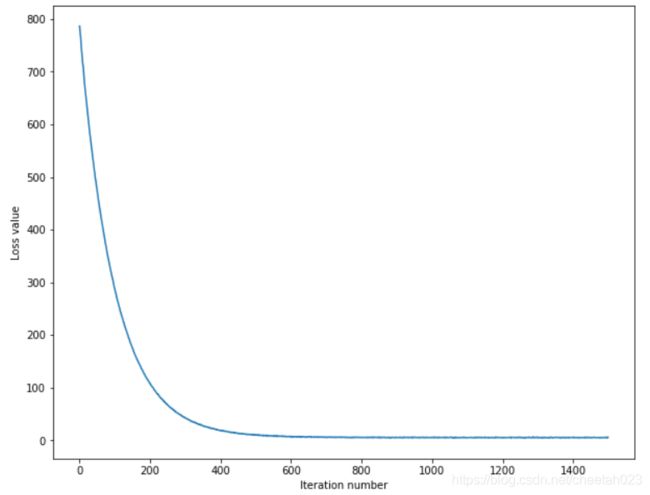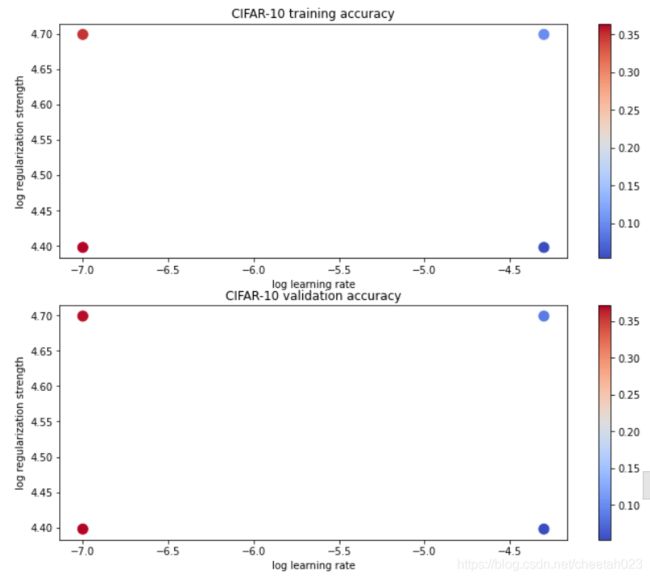2020 cs231n 作业1笔记 svm
目录
Multiclass Support Vector Machine loss(SVM loss)
求loss:
求梯度:
svm_loss_naive
svm_loss_vectorized
SGD
tune hyperparameters
Multiclass Support Vector Machine loss(SVM loss)
求loss:
SVM的损失函数想要SVM在正确分类上的得分始终比不正确分类上的得分高出一个边界值![]() 。
。
如果正确分类得分比不正确分类得分高出![]() ,则损失为0,否则为:正确分类得分 - 不正确分类得分 +
,则损失为0,否则为:正确分类得分 - 不正确分类得分 + ![]()
损失函数的公式:
计算例子:
求梯度:
参考:Computing the gradient analytically with Calculus
直观理解根据损失函数的公式两边求导,
svm_loss_naive
首先完成cs231n/classifiers/linear_svm.py的svm_loss_naive(W, X, y, reg)函数,使用L2 Regularization
def svm_loss_naive(W, X, y, reg):
"""
Structured SVM loss function, naive implementation (with loops).
Inputs have dimension D, there are C classes, and we operate on minibatches
of N examples.
Inputs:
- W: A numpy array of shape (D, C) containing weights.
- X: A numpy array of shape (N, D) containing a minibatch of data.
- y: A numpy array of shape (N,) containing training labels; y[i] = c means
that X[i] has label c, where 0 <= c < C.
- reg: (float) regularization strength
Returns a tuple of:
- loss as single float
- gradient with respect to weights W; an array of same shape as W
"""
dW = np.zeros(W.shape) # initialize the gradient as zero
# compute the loss and the gradient
num_classes = W.shape[1]
num_train = X.shape[0]
loss = 0.0
for i in range(num_train):
scores = X[i].dot(W)
correct_class_score = scores[y[i]]
for j in range(num_classes):
if j == y[i]:
continue
margin = scores[j] - correct_class_score + 1 # note delta = 1
if margin > 0:
loss += margin
dW[:,j] += X[i,:]
dW[:,y[i]] -= X[i,:]
# Right now the loss is a sum over all training examples, but we want it
# to be an average instead so we divide by num_train.
loss /= num_train
dW /= num_train
# Add regularization to the loss.
loss += reg * np.sum(W * W)
dW += 2 * reg * W
#############################################################################
# TODO: #
# Compute the gradient of the loss function and store it dW. #
# Rather than first computing the loss and then computing the derivative, #
# it may be simpler to compute the derivative at the same time that the #
# loss is being computed. As a result you may need to modify some of the #
# code above to compute the gradient. #
#############################################################################
# *****START OF YOUR CODE (DO NOT DELETE/MODIFY THIS LINE)*****
# *****END OF YOUR CODE (DO NOT DELETE/MODIFY THIS LINE)*****
return loss, dWsvm_loss_vectorized
然后是向量化实现:svm_loss_vectorized(W, X, y, reg)
def svm_loss_vectorized(W, X, y, reg):
"""
Structured SVM loss function, vectorized implementation.
Inputs and outputs are the same as svm_loss_naive.
"""
loss = 0.0
dW = np.zeros(W.shape) # initialize the gradient as zero
#############################################################################
# TODO: #
# Implement a vectorized version of the structured SVM loss, storing the #
# result in loss. #
#############################################################################
# *****START OF YOUR CODE (DO NOT DELETE/MODIFY THIS LINE)*****
num_train = X.shape[0]
score = np.dot(X, W)
margin = score - score[range(num_train),y].reshape(-1,1) + 1
margin[range(num_train),y] = 0
margin = (margin > 0) * margin
loss = np.sum(margin) / num_train
loss += reg * np.sum(W * W)
# *****END OF YOUR CODE (DO NOT DELETE/MODIFY THIS LINE)*****
#############################################################################
# TODO: #
# Implement a vectorized version of the gradient for the structured SVM #
# loss, storing the result in dW. #
# #
# Hint: Instead of computing the gradient from scratch, it may be easier #
# to reuse some of the intermediate values that you used to compute the #
# loss. #
#############################################################################
# *****START OF YOUR CODE (DO NOT DELETE/MODIFY THIS LINE)*****
flag = (margin > 0).astype(int)
#统计每行margin值>0的个数n,用于下一步dW[:,y[i]] -= n * X[i,:]
flag[range(num_train), y] = - np.sum(flag, axis = 1)
#dW[:,j] += X[i,:]
#dW[:,y[i]] -= n * X[i,:]
#两步一起做
dW = np.dot(X.T, flag) / num_train
dW += 2 * reg * W
# *****END OF YOUR CODE (DO NOT DELETE/MODIFY THIS LINE)*****
return loss, dW
SGD
接下来就是使用SGD训练减少loss,优化参数
流程大概就是:
随机初始化W
for(迭代次数):
{
随机选batch_size个训练样本
计算loss ,gradient
W -= learning_rate * gradient
}
def train(self, X, y, learning_rate=1e-3, reg=1e-5, num_iters=100,
batch_size=200, verbose=False):
"""
Train this linear classifier using stochastic gradient descent.
Inputs:
- X: A numpy array of shape (N, D) containing training data; there are N
training samples each of dimension D.
- y: A numpy array of shape (N,) containing training labels; y[i] = c
means that X[i] has label 0 <= c < C for C classes.
- learning_rate: (float) learning rate for optimization.
- reg: (float) regularization strength.
- num_iters: (integer) number of steps to take when optimizing
- batch_size: (integer) number of training examples to use at each step.
- verbose: (boolean) If true, print progress during optimization.
Outputs:
A list containing the value of the loss function at each training iteration.
"""
num_train, dim = X.shape
num_classes = np.max(y) + 1 # assume y takes values 0...K-1 where K is number of classes
if self.W is None:
# lazily initialize W
self.W = 0.001 * np.random.randn(dim, num_classes)
# Run stochastic gradient descent to optimize W
loss_history = []
for it in range(num_iters):
X_batch = None
y_batch = None
#########################################################################
# TODO: #
# Sample batch_size elements from the training data and their #
# corresponding labels to use in this round of gradient descent. #
# Store the data in X_batch and their corresponding labels in #
# y_batch; after sampling X_batch should have shape (batch_size, dim) #
# and y_batch should have shape (batch_size,) #
# #
# Hint: Use np.random.choice to generate indices. Sampling with #
# replacement is faster than sampling without replacement. #
#########################################################################
# *****START OF YOUR CODE (DO NOT DELETE/MODIFY THIS LINE)*****
lists = np.random.choice(num_train, batch_size)
X_batch = X[lists,:]
y_batch = y[lists]
# *****END OF YOUR CODE (DO NOT DELETE/MODIFY THIS LINE)*****
# evaluate loss and gradient
loss, grad = self.loss(X_batch, y_batch, reg)
loss_history.append(loss)
# perform parameter update
#########################################################################
# TODO: #
# Update the weights using the gradient and the learning rate. #
#########################################################################
# *****START OF YOUR CODE (DO NOT DELETE/MODIFY THIS LINE)*****
self.W -= learning_rate * grad
# *****END OF YOUR CODE (DO NOT DELETE/MODIFY THIS LINE)*****
if verbose and it % 100 == 0:
print('iteration %d / %d: loss %f' % (it, num_iters, loss))
return loss_history可以得到loss曲线和accuracy:
training accuracy: 0.374776
validation accuracy: 0.385000
tune hyperparameters
最后是调超参数,找到validation accuracy最高的超参数(learning_rate 和 reg)
# Provided as a reference. You may or may not want to change these hyperparameters
learning_rates = [1e-7, 5e-5]
regularization_strengths = [2.5e4, 5e4]
# *****START OF YOUR CODE (DO NOT DELETE/MODIFY THIS LINE)*****
for lr in learning_rates:
for reg in regularization_strengths:
svm = LinearSVM()
svm.train(X_train, y_train, learning_rate=lr, reg=reg, num_iters=1500)
y_train_pred = svm.predict(X_train)
train_accuracy = np.mean(y_train == y_train_pred)
y_val_pred = svm.predict(X_val)
val_accuracy = np.mean(y_val == y_val_pred)
results[(lr,reg)] = (train_accuracy, val_accuracy)
if val_accuracy > best_val:
best_val = val_accuracy
best_svm = svm
# *****END OF YOUR CODE (DO NOT DELETE/MODIFY THIS LINE)*****打印结果:
lr 1.000000e-07 reg 2.500000e+04 train accuracy: 0.363878 val accuracy: 0.371000
lr 1.000000e-07 reg 5.000000e+04 train accuracy: 0.349000 val accuracy: 0.368000
lr 5.000000e-05 reg 2.500000e+04 train accuracy: 0.054041 val accuracy: 0.053000
lr 5.000000e-05 reg 5.000000e+04 train accuracy: 0.100265 val accuracy: 0.087000
best validation accuracy achieved during cross-validation: 0.371000
在test测试集上的accuracy:
linear SVM on raw pixels final test set accuracy: 0.361000





